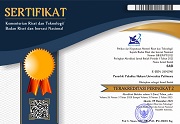Legal Protection for Soybean Farmers in Cooperation Based on the Muzara'ah Akad with the Murabahah System
 ), A’an Efendi(2), Nuzulia Kumala Sari(3)
), A’an Efendi(2), Nuzulia Kumala Sari(3)
(1) Faculty of Law University of Jember, Jember, Indonesia
(2) Faculty of Law University of Jember, Jember, Indonesia
(3) Faculty of Law University of Jember, Jember, Indonesia
 Corresponding Author
Corresponding Author
Abstract
Introduction: During the pandemic Covid-19, the global soybean market experienced a shock which resulted in the availability of imported soybeans in several countries decreasing and soybean prices increasing. This also has an impact on small and medium industries that cannot afford soybeans for their processed food raw materials, one of which is the production of “tempe”.
Purposes of the Research: The purpose of this study is to explain the concept of cooperation to provide legal protection to soybean farmers based on a muzara'ah akad with a murabahah system.
Methods of the Research: The research method used is normative legal research with a statute legal approach and a conceptual approach.
Results of the Research: The result of this study include 2 (two) things, namely the concept of cooperation and the form of legal protection. The concept of cooperation consists of: The first scheme, cooperation between the government (Pemda) with soybean farmers and Islamic banks. The second scheme is the cooperation of Islamic banks with soybean farmers using a murabahah akad. The third scheme, namely cooperation between soybean farmers and cultivator using muzara’ah akad. In connection with the form of legal protection, it is divided into 2 (two) namely: first, external legal protection regulated in Law Number 19 of 2013 concerning Protection and Empowerment of Farmers, which was later changed to Law no. 11 of 2020 concerning Job Creation, and second, internal legal protection, namely 3 (three) concepts of cooperation as outlined in a written agreement as a form of guarantee of legal certainty for the parties, especially for soybean farmers.Keywords
DOI
10.47268/sasi.v28i2.765
Published
2022-05-16
How To Cite
@article{SASI765,
author = {Dyah Susanti and A’an Efendi and Nuzulia Sari},
title = {Legal Protection for Soybean Farmers in Cooperation Based on the Muzara'ah Akad with the Murabahah System},
journal = {SASI},
volume = {28},
number = {2},
year = {2022},
keywords = {Legal Protection; Muzara’ah Akad; Murabahah System},
abstract = {Introduction: During the pandemic Covid-19, the global soybean market experienced a shock which resulted in the availability of imported soybeans in several countries decreasing and soybean prices increasing. This also has an impact on small and medium industries that cannot afford soybeans for their processed food raw materials, one of which is the production of “tempe”. Purposes of the Research: The purpose of this study is to explain the concept of cooperation to provide legal protection to soybean farmers based on a muzara'ah akad with a murabahah system. Methods of the Research: The research method used is normative legal research with a statute legal approach and a conceptual approach. Results of the Research: The result of this study include 2 (two) things, namely the concept of cooperation and the form of legal protection. The concept of cooperation consists of: The first scheme, cooperation between the government (Pemda) with soybean farmers and Islamic banks. The second scheme is the cooperation of Islamic banks with soybean farmers using a murabahah akad. The third scheme, namely cooperation between soybean farmers and cultivator using muzara’ah akad. In connection with the form of legal protection, it is divided into 2 (two) namely: first, external legal protection regulated in Law Number 19 of 2013 concerning Protection and Empowerment of Farmers, which was later changed to Law no. 11 of 2020 concerning Job Creation, and second, internal legal protection, namely 3 (three) concepts of cooperation as outlined in a written agreement as a form of guarantee of legal certainty for the parties, especially for soybean farmers.},
issn = {2614-2961}, pages = {214--224} doi = {10.47268/sasi.v28i2.765},
url = {https://fhukum.unpatti.ac.id/jurnal/sasi/article/view/765}
}
Journal
Abdillah. “Murabahah Li Al-Aaamir Bi Al-Syira` and Its Implementation In Concept Of Financing at Sharia Financial Institutions In Indonesia.” Journal of Economicate Studies 1, no. 1 (2017), 9-22. DOI:https://doi.org/10.32506/joes.v1i1.4.
Angriani, Parida. “Perlindungan Hukum Konsumen terhadap Kartel Kedelai dalam Perspektif Hukum Persaingan Usaha Tidak Sehat”. Jurnal IUS: Kajian Hukum dan Keadilan 2, no. 1 (2014), 153-163. DOI: http://dx.doi.org/10.12345/ius.v2i4.163
Hanum, Nurlaila & Salman, & Gesya Gebine. “Analisis Dampak Kenaikan Harga Kacang Kedelai Terhadap Pendapatan UMKM Tempe di Kota Langsa.” Jurnal Samudra Ekonomika 3, no. 2 (2019): 141-153. DOI: https://doi.org/10.0123/jse.v3i2.1888
Mahdi, N.N & Suharno. “Analisis Faktor-Faktor Yang Memengaruhi Impor Kedelai di Indonesia.” Forum Agribisnis: Agribusiness Forum 9, no. 2 (2019), 160-184. DOI: https://doi.org/10.29244/fagb.9.2.160-184.
Nita, Shania Verra. “Kajian Muzara'ah dan Musaqah (Hukum Bagi Hasil Pertanian dalam Islam).” Jurnal Qawanin 4, no. 2 (2020), 236-249. DOI: https://doi.org/10.30762/qawanin.v4i2.2503.
Nola, Luthvi Febryka. “Upaya Pelindungan Hukum Secara Terpadu Bagi Tenaga Kerja Indonesia (TKI).” Jurnal Negara Hukum 7, no. 1 (2016), 35-52. DOI: https://doi.org/10.22212/jnh.v7i1.949.
Nugraha, Jefri Putri. “Sistem Muzara’ah Sebagai Alternatif Pembiayaan Pertanian di Indonesia.” Jurnal Iqtishodia 1, no. 2 (2016), 81-103. DOI: https://doi.org/10.35897/iqtishodia.v1i2.66.
Subiharta. “Moralitas Hukum Dalam Hukum Praksis Sebagai Suatu Keutamaan.” Jurnal Hukum dan Peradilan 4, no. 3 (2015), 385-398. DOI: https://doi.org/10.25216/jhp.4.3.2015.385-398.
Suciati. “Perlindungan Hukum terhadap Petani dalam Menggapai Negara Kesejahteraan (Welfare State).” Jurnal Moral Kemasyarakatan 1, no. 2 (2016), 149-161. DOI: https://doi.org/10.21067/jmk.v1i2.1532.
Wahyuningrum, Ana Liana & Darwanto. “Penerapan Bagi Hasil Maro Perspektif Akad Mukhabarah.” Tawazun: Journal of Sharia Economic Law 3, no. 1 (2020), 45-62. DOI: https://doi.org/10.21043/tawazun.v3i1.7544.
Book
Dyah Ochtorina Susanti & A’an Efendi. Penelitian Hukum (Legal Research). Jakarta: Sinar Grafika, 2014.
Isnaeni. M. Seberkas Diorama Hukum Kontrak. Surabaya: Revka Petra Media, 2018
Mardani. Fiqh Ekonomi Syari’ah. Jakarta: Kencana Prenada Media Group, 2012.
Rahman, A. et.al. Fiqh Muamalat. Jakarta: Kencana, 2010.
Suhendi, Hendi. Fiqih Mu’amalah. Jakarta: Raja Grafindo Persada, 2013.
Tim Redaksi Tesaurus Bahasa Indonesia. Tesaurus Bahasa Indonesia Pusat Bahasa. Jakarta: Pusat Bahasa Departemen Pendidikan Nasional, 2008.
Thesis, Web Page, and Others
Erwin Syahputra. Pengentasan Kemiskinan Melalui Hukum Sebagai Sarana Pemberdayaan CSR( Corporate Social Responsibility) Dalam Kegiatan Pertambangan Emas Di Tapanuli Selatan. Semarang: Program Magister Ilmu Hukum Fakultas Hukum Universitas Diponegoro, Tesis, 2017.
https://news.kemendag.go.id/berita/NewsDetail.aspx?v=8588.
https://finance.detik.com/berita-ekonomi-bisnis/d-5324643/harga-kedelai-rp-8500kg-ditahan-3-bulan.
https://tirto.id/rezim-impor-pangan-karena-uu-cipta-kerja-jokowi-f6im.
| Dublin Core | PKP Metadata Items | Metadata for this Document | |
| 1. | Title | Title of document | Legal Protection for Soybean Farmers in Cooperation Based on the Muzara'ah Akad with the Murabahah System |
| 2. | Creator | Author's name, affiliation, country | Dyah Ochtorina Susanti; Faculty of Law University of Jember, Jember; Indonesia |
| 2. | Creator | Author's name, affiliation, country | A’an Efendi; Faculty of Law University of Jember, Jember; Indonesia |
| 2. | Creator | Author's name, affiliation, country | Nuzulia Kumala Sari; Faculty of Law University of Jember, Jember; Indonesia |
| 3. | Subject | Discipline(s) | |
| 3. | Subject | Keyword(s) | Legal Protection; Muzara’ah Akad; Murabahah System |
| 4. | Description | Abstract | Introduction: During the pandemic Covid-19, the global soybean market experienced a shock which resulted in the availability of imported soybeans in several countries decreasing and soybean prices increasing. This also has an impact on small and medium industries that cannot afford soybeans for their processed food raw materials, one of which is the production of “tempe”. Purposes of the Research: The purpose of this study is to explain the concept of cooperation to provide legal protection to soybean farmers based on a muzara'ah akad with a murabahah system. Methods of the Research: The research method used is normative legal research with a statute legal approach and a conceptual approach. Results of the Research: The result of this study include 2 (two) things, namely the concept of cooperation and the form of legal protection. The concept of cooperation consists of: The first scheme, cooperation between the government (Pemda) with soybean farmers and Islamic banks. The second scheme is the cooperation of Islamic banks with soybean farmers using a murabahah akad. The third scheme, namely cooperation between soybean farmers and cultivator using muzara’ah akad. In connection with the form of legal protection, it is divided into 2 (two) namely: first, external legal protection regulated in Law Number 19 of 2013 concerning Protection and Empowerment of Farmers, which was later changed to Law no. 11 of 2020 concerning Job Creation, and second, internal legal protection, namely 3 (three) concepts of cooperation as outlined in a written agreement as a form of guarantee of legal certainty for the parties, especially for soybean farmers. |
| 5. | Publisher | Organizing agency, location | Faculty of Law, Universitas Pattimura |
| 6. | Contributor | Sponsor(s) | |
| 7. | Date | (YYYY-MM-DD) | 2022-05-16 |
| 8. | Type | Status & genre | Peer-reviewed Article |
| 8. | Type | Type | |
| 9. | Format | File format | |
| 10. | Identifier | Uniform Resource Identifier | https://fhukum.unpatti.ac.id/jurnal/sasi/article/view/765 |
| 10. | Identifier | Digital Object Identifier | 10.47268/sasi.v28i2.765 |
| 11. | Source | Title; vol., no. (year) | SASI; Volume 28 Issue 2, June 2022 |
| 12. | Language | English=en | en |
| 13. | Relation | Supp. Files |
Untitled (202KB) |
| 14. | Coverage | Geo-spatial location, chronological period, research sample (gender, age, etc.) | |
| 15. | Rights | Copyright and permissions | Copyright: Authors who publish their manuscripts in this Journal agree to the following conditions: 1. The copyright in each article belongs to the author, as well as the right to patent. 2. Authors can enter into separate, additional contractual arrangements for the non-exclusive distribution of the journal's published version of the work (e.g., post it to an institutional repository or publish it in a book), with an acknowledgment of its initial publication in this journal. 3. Authors are permitted and encouraged to post their work online (e.g., in institutional repositories or on their website) before and during the submission process, as it can lead to productive exchanges, as well as earlier and greater citation of published work. 4. Authors have the right to self-archiving of the article (Author Self-Archiving Policy)
License: The SASI Journal is disseminated based on the Creative Commons Attribution-NonCommercial 4.0 International license terms. This license allows anyone to copy and redistribute this material in any form or format, compose, modify, and make derivatives of this material for any purpose. You cannot use this material for commercial purposes. You must specify an appropriate name, include a link to the license, and certify that any changes have been made. You can do this in a way that is appropriate but does not imply that the licensor supports you or your use.
|
Copyright (c) 2022 Dyah Ochtorina Susanti, A’an Efendi, Nuzulia Kumala Sari

This work is licensed under a Creative Commons Attribution-NonCommercial 4.0 International License.

 : 2877 times
: 2877 times Download : 1589 times
Download : 1589 times
















